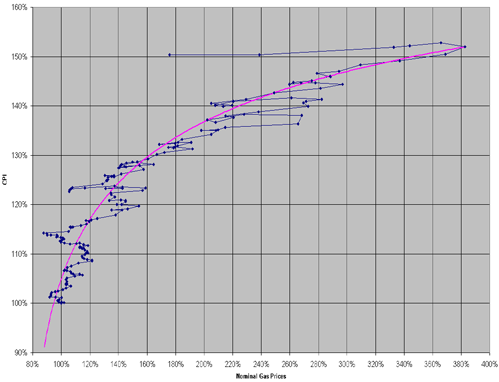
The above graph is an idealized model of the relative gains to production efficiency and relative losses from destruction of traditional lifestyle that accompanies the adoption of varying degrees of mass production of goods.
No society will be at either extreme of this graph. At the left end, there is the society where nothing is mass produced. However, there are always things which are better left done in a uniform or assembly line fashion. Many of these are component goods such as paper; others may require high degrees of quality assurance, such as condoms. At the right end we find a society where all good are produced in factories. Not even so much as dinner in the evening is done by hand. Perhaps in this world all food is cooked and eaten in massive cafeterias with giant industrial ducting sucking air toward a depressingly high ceiling. This, and other meditations, indicate that the marginal loss is least when the first unit of a respective type is introduced, and greatest when the last unit of the other type is removed.
The gains from mass producing any commodity come in the form of efficiency of labor, commonly called productivity. Productivity is good because it means less labor is used to produce a given quantity of goods, meaning that either less work is required in total and therefore more leisure is available to the populace, or more total goods can be produced at a given level of employment, or some combination of the two. Therefore, the society that is more productive will generally have lower levels of employment and greater availability of goods.
The losses from mass producing any given commodity come in the driving of traditional craftsmen (truly craftspersons, but I just don't want to make my writing opaque by using awkward, gender ambiguous language) out of the market. Craftsmen produce goods that are artistically diverse, and therefore create a rich cultural tradition, whereas mass produced goods are by definition homogeneous. Furthermore, a rich cultural tradition provides a context in which individuals are able to express themselves, either through Petit Bourgeoisie or non-commercial expression. Therefore, having a high level of traditional craftsmanship implies that a society will offer artistically diverse products and greater opportunities for individual creativity.
Total consumption bundles are only composed of goods and services. Of the total goods consumed, each good is either mass produced or the work of a craftsman. To a certain degree, movement along the distribution will lead to changes in total goods consumed, with more being consumed as one moves toward complete manufacturing of goods. Now I postulate a bliss point, which is a saturation point where individuals do not desire more goods. Since the consumption curve (not pictured) is smooth, a diminishing marginal propensity to consume as the availability of goods increases is the only means of achieving a bliss point. Assume now that the means of production, affluence and availability of goods are sufficient for the bliss point to fall in the spectrum of mass production pictured. Following along the lines of a typical Keynesian employment argument we see that as new manufacturing jobs are added, demand for goods will not expand sufficiently to maintain a steady level of employment. Therefore, employment levels will go down as expanding mass production increases average productivity, or to put it nicely, more people will enjoy more leisure time (work is not water, after all). If the reader is not satisfied with my argument in this paragraph, a much more detailed argument of a similar character has been made by Karl Marx.
A higher level of total good consumption is generally correlated to higher levels of benefits like adequate nutrition, shelter, and information availability; harms such as environmental destruction and anomie; and indeterminates including personal effects, luxury items, and consumer individuality.
Following my argument two paragraphs ago, we may expect lower employment to accompany high levels of mass production. A lower level of employment is generally correlated to higher levels of leisure time. Though generally accepted, the idea that a person should work at least 40 hours a week can be meaningfully challenged. Work is not inherently virtuous. Leisure has benefits like greater time for childraising, education, and relaxation; harms such as unemployment and criminal mischief; and indeterminates including controversial labor distributions.
Because the production levels of hand crafted goods are low, the diminishing marginal propensity to consume will not significantly affect craftsmen. Craftsmanship, however, does require individual skill. In addition to knowledge of the craft, it also involves business savvy, interpersonal finesse, creativity, and risk taking. Not all individuals will possess such skills, but the degree to which they can be learned is probably high. Communities will not be free from exceptions to this rule of merit, such as rivalries, oppression of individuality, and the like. However, subcultural differences make the negative behavior of other cultures stick out while the negative behavior common to our circles goes unnoticed. Specifically, I reject as completely baseless the belief that poverty and a lack of industrialization have any causative effect on the formation of such negative behaviors in societies. Therefore, a society that features more crafts will be one that rewards excellence, and because of the assumption of learnability, cultivates artisan traditions in order to make such excellence teachable.
A higher level of artisan traditions is generally correlated to benefits like cultural or artistic diversity, and consumer choice; harms such as supply surpluses and shortages, lack of information collection, and lack of documentation; and indeterminates including informal assessments of quality and loss of national identity.
A higher level of rewards for excellence in individuals is generally correlated to benefits like community participation, greater internalization of ethical principles, and higher self esteem; it has no definite harms but does have indeterminates including hypersensitivity to social injustice, overabundance of schools of thought, easy identification of the mediocre, and docility.
It is clear from this graph that craftsmen play an important role in a society. Furthermore, there is cause to believe that in the regulatory environment favored by classical liberalism, mass production is unfairly favored competitively against craftsmanship. It is worth observing here that the regulatory environment is not totally separable from the definitions of concepts in classical economics. Liberalism of markets is both a political and economic stance, and it is synonymous with both the state of regulation that it favors and the economic models that justify it.
An analysis of the effects of the respective approaches reveals that in the case of mass production, classical liberalism gives the results of mass production first to the Capitalist. He is first to recieve adequate shelter, nutrition, education, relaxation time, and even time to properly raise a child. His control of information is best seen in the proliferation of advertising, specifically through the power of corporations to define our very goals in life. The harms of mass production do not affect the Capitalist until the very last. It is the masses that suffer from environmental destruction, anomie, unemployment, and crime.
It is the opposite that is true for the craftsman. As the number of craftsmen in a society increases, few of the benefits accrue directly to the craftsmen. While a certain critical mass of craftsmen may be necessary to build an artisan tradition, this is not generally the case. Certainly, the increases in self-esteem are felt by the craftsman, first and foremost. However, the remainder of the effect that is created is felt by the society as a whole. The fabric of the society itself is woven from the perception by the individuals that the role they are playing is important to the society and therefore allows them a certain degree of control. When the harms associated with traditional craftsmanship are felt, they are felt by the craftsmen themselves, who go out of business when supply is imbalanced, and suffer first for their own lack of documentation.
The interplay between these two is therefore one where a natural subsidy exists for mass production. As each new large-scale business is founded, the entrepreneur never reimburses the remaining craftspeople for the work they have done in producing a stable society that has a docile consumer base of ethical workers, marketable artisan imagery, rich natural resources, low crime, and a healthy community that will attract the necessary skilled foreign workers. As mass production drives the craftspeople out, the social decline is gradual, but very difficult to reverse. Methods and traditions are lost to extinction. It helps least of all that laws and customs that did not evolve with mass production in mind provide security to the capitalist once his act of injustice has come to light.
Any historical example of this process will show how wrong it is to equate the best interest of the individual with that of the society through any simple set of relations. To do so presupposes a set of conditions where interrelations feature symmetric negotiating power. On the contrary, human interrelations are asymmetric, with a symmetry only in the statistical aggregate. The individual who stumbles upon the power to force his costs onto others will on occasion do so, and even if his act is inadvertent, evolutionary effects dictate that eventually such individuals will dominate over others. The only check on this effect, and probably the reason there is justice at all in this world, is that humans have evolved to have an innate sense of fairness. However, our innate ideas are relics of an evolutionary past that predates anything resembling modern industry. It is utter madness to believe that our innate ideas, specifically our concept of fairness, do not have a profound effect on economic markets. We must therefore be weary that new technologies such as mass production do not mislead the heuristic reasoning that creates the average person's concept of justice.
It is also possible that the destruction of traditional methods will almost always precipitate an environmental disaster. In times without modern technology, a community that made such a choice would simply perish with it. Today, we have the power to destroy everything.
So, I guess that is as good an argument as any for a resurgence of crafts movements. I am not advocating the complete abandonment of mass production. Rather, we should recognize that there are positive externalities to be rewarded for crafts, and negative externalities to be taxed with regard to mass production.


